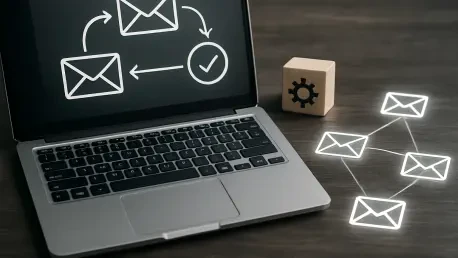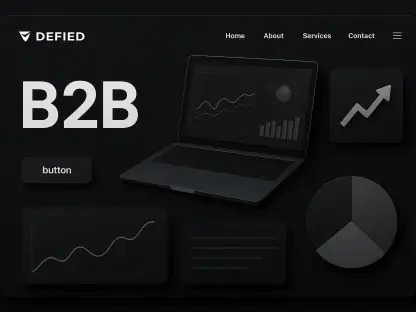Imagine a scenario where a business could generate half of its email marketing revenue without constant manual intervention, simply by setting up a system that works tirelessly in the background to nurture customer relationships. This is not a far-fetched dream but a reality for many retailers who have harnessed the power of automated email journeys. These sophisticated sequences of emails, triggered by specific customer actions, have become the backbone of modern email marketing programs. By automating repetitive tasks, they free up valuable time for marketers to focus on creative campaigns and strategic growth. However, the question remains: are these automated systems being utilized to their fullest potential? Many businesses have basic journeys in place, yet fail to optimize them for maximum revenue. Exploring how to refine and expand these processes can unlock significant financial gains, making it a critical area for any marketing team to address.
1. Understanding Email Journeys as Revenue Generators
Email journeys represent a powerful tool in the arsenal of digital marketing, defined as a series of automated emails sent in response to specific customer behaviors or actions. These journeys are not just about sending messages; they are about creating a seamless interaction with customers at key moments in their relationship with a brand. Whether it’s a welcome email after a signup or a reminder for an abandoned cart, these automated sequences ensure timely and relevant communication. Their ability to operate without constant oversight makes them akin to “money trees,” consistently producing revenue while marketers focus on other priorities. The impact is clear, as many retailers report that over 50% of their email revenue comes directly from such automations, highlighting their importance in a competitive market.
Maintaining these journeys, however, is not a one-time task but an ongoing responsibility. Just as a garden requires regular tending to yield the best harvest, email journeys need consistent review and updates to remain effective. Changes in customer behavior, outdated content, or technical glitches can diminish their impact over time. Regular audits ensure that the messaging aligns with current trends and customer expectations, preventing potential revenue loss. By investing time in nurturing these automated sequences, businesses can sustain and even grow the passive income they generate, solidifying email journeys as a cornerstone of a successful marketing strategy.
2. Tracing the Evolution from Automations to Journeys
The concept of automated emails has evolved significantly over the years, transitioning from simple “automations” to comprehensive “journeys.” Initially, automations were straightforward triggered messages, such as a purchase confirmation sent immediately after a transaction. This term shifted with the introduction of advanced tools like Salesforce’s Journey Builder, which allowed for more intricate sequences of emails tailored to customer interactions. This redefinition encouraged marketers to view these processes not just as isolated messages but as part of a broader customer experience with a brand. The shift in terminology reflects a deeper understanding of how interconnected and personalized email communication can enhance engagement and loyalty.
To clarify the distinctions, consider the different levels of automation: a trigger mail is a single, transactional email, like a receipt for a purchase. An automation typically involves a short series of one or two emails sent to all who meet the trigger condition, such as a shipping confirmation followed by a delivery notice. A journey, however, spans a longer series of three or more emails, each with a distinct purpose, often customized using customer data to determine the next message and timing. An example is an onboarding series that welcomes new subscribers, introduces the brand, and guides them toward a first purchase or account setup. Understanding these differences is crucial for designing effective email strategies that resonate with diverse customer segments and drive meaningful results.
3. Defining Inclusions and Exclusions for Targeted Journeys
Creating a successful email journey begins with a clear understanding of who should and should not receive specific messages. Identifying the target audience for each email within a series is as critical as determining exclusions to avoid irrelevant communication. For instance, a journey for first-time buyers should differ from one designed for repeat customers or loyalty program members. Similarly, a win-back campaign for lapsed customers requires a distinct approach compared to one for those who have never purchased. Accurate data plays a pivotal role here, ensuring that loyal customers are not mistakenly treated as newcomers, which could lead to dissatisfaction or disengagement. This step lays the foundation for personalized and effective email interactions.
Beyond identifying the right recipients, the process of setting exclusions can often be more challenging yet equally important. Sending emails to the wrong audience wastes resources and risks alienating customers with content that does not apply to them. Detailed segmentation based on purchase history, engagement levels, or other behavioral data helps refine these lists. For example, excluding loyal customers from introductory offers meant for new subscribers prevents redundancy and maintains trust. By carefully defining these parameters, businesses can ensure that each email journey delivers value to the intended recipients, maximizing impact and fostering stronger customer relationships through relevant and timely communication.
4. Building Journeys Incrementally for Lasting Success
Constructing effective email journeys is not an overnight endeavor but a gradual process that requires patience and persistence. A compelling example comes from a consultation with a major financial institution, where the email team leader showcased an extensive chart of automations and journeys built over years. The approach was methodical: starting with a single automation, refining it based on performance, and then moving on to the next. This step-by-step method underscores the importance of not rushing to create complex systems in one sitting. Instead, launching a basic journey and iterating on it allows for adjustments based on real-world feedback and performance metrics, ensuring each journey is robust before expanding the program.
This incremental approach also mitigates the risk of lost momentum and revenue. Waiting for perfection before launching a journey can delay critical customer engagement and hinder other marketing initiatives. By releasing a foundational version and building upon it, marketers can learn from tests and operational data to inform future enhancements. Each iteration offers insights into customer preferences and behaviors, which can be used to fine-tune messaging and timing. This cycle of launch, review, and improve ensures that email journeys remain dynamic and aligned with evolving business goals, ultimately driving sustained growth without overwhelming the team or resources.
5. Mapping Complex Pathways for Comprehensive Journeys
Unlike basic automations that follow linear flows with minimal variables, email journeys are intricate systems that account for a wide range of data points and customer behaviors. These journeys should be envisioned as detailed maps, much like a highway network with multiple routes and decision points. Factors such as past purchases, click patterns, industry specifics, or even company size can influence which emails are sent and when. A financial services company, for instance, tailored its journey to adjust content based on user interactions, business type, employee numbers, and sales figures. This level of customization ensures that each customer receives highly relevant messages, enhancing engagement and conversion rates.
Planning such complex journeys demands significant time and foresight to anticipate every possible scenario or outcome before crafting the emails or setting up triggers. Rushing this process can lead to gaps in logic or missed opportunities to connect with customers at critical touchpoints. Marketers must consider how different data inputs might alter the journey’s direction, ensuring that each path is accounted for in the design phase. By investing in thorough mapping, businesses can create email journeys that adapt dynamically to individual customer needs, delivering personalized experiences that stand out in a crowded inbox and drive meaningful business outcomes.
6. Committing to Regular Review and Updates
One of the most detrimental mindsets in email marketing history was the notion of “set it and forget it” when it came to automations. This approach often led to issues like broken links due to website updates, outdated data from disconnected CRM systems, or shifts in customer expectations that rendered content obsolete. Templates can also become stale, failing to reflect current branding or trends. The reality is that the digital landscape evolves constantly, and email journeys must adapt to these changes to remain effective. Neglecting this maintenance is akin to running a vehicle without regular checkups, inevitably leading to breakdowns that could have been prevented.
To avoid such pitfalls, scheduling consistent reviews and testing of email journeys is essential. Before launching any automation, thorough testing ensures all components function as intended. Post-launch, periodic retesting validates initial assumptions and identifies areas for improvement. A notable case from a major retailer revealed that the optimal timing for follow-up emails on accessory purchases shifted over time, requiring adjustments based on repeated testing. This underscores the need to continuously revisit data and experiment with variables like send times or message content. By committing to regular updates, businesses ensure their email journeys remain relevant and effective, safeguarding revenue streams.
7. Sustaining Growth Through Optimized Email Strategies
Reflecting on the past, it’s evident that marketing automation platforms evolved to become more intuitive and seamlessly integrated with CRM systems, even within basic email service providers. This advancement made it easier for businesses to implement and manage sophisticated email journeys. The benchmark of 50% revenue from automations served as a useful measure to evaluate whether existing programs were sufficient or needed expansion. Companies falling below this threshold recognized the need for additional automations, while those exceeding it demonstrated exceptional performance in leveraging these tools for financial success.
Looking back, the focus on incremental innovation proved vital in refining email journeys over time, much like adjusting to new dynamics in a household with multiple pets. Triggered messages, whether single emails, short automated series, or full-scale journeys, consistently outperformed generic bulk emails in driving engagement and conversions. The lesson was clear: ongoing optimization and adaptation were key to sustaining growth. Businesses that prioritized regular updates and data-driven adjustments to their email strategies positioned themselves for long-term success, ensuring that automated communications continued to deliver value to both the company and its customers.









